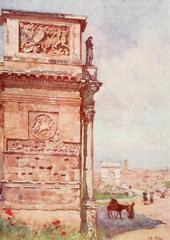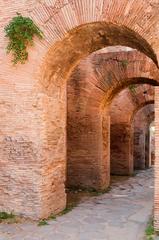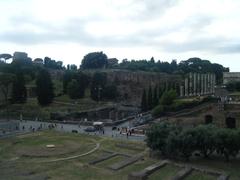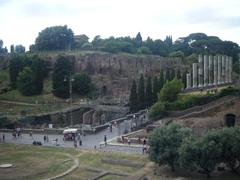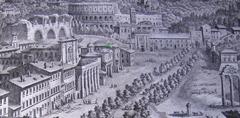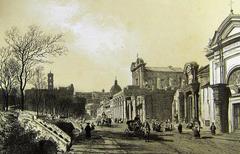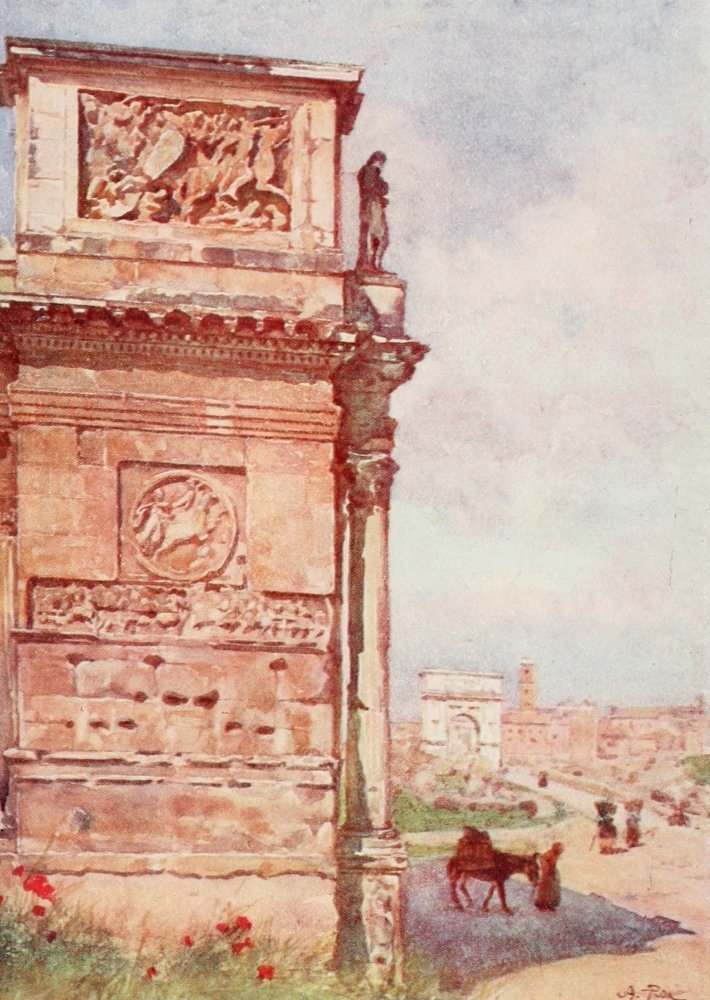
Via Sacra Rome: Visiting Hours, Tickets, and Historical Significance Guide
Date: 14/06/2025
Introduction
The Via Sacra, or “Sacred Way,” is one of the most storied and significant streets in ancient Rome. Running through the heart of the Roman Forum, it served for centuries as the main artery of religious, political, and social life in the city. From the 6th century BCE, the Via Sacra evolved from a simple path into a monumental roadway, lined with temples and public buildings, and became the stage for imperial triumphs, sacred rituals, and the everyday bustle of Roman citizens. Today, walking the Via Sacra is a journey back in time, offering visitors a tangible connection to Rome’s layered past and enduring legacy (The Geographical Cure; Ancient Rome Live; Visit Colosseum Rome).
This comprehensive guide covers the Via Sacra’s origins, evolution, major landmarks, visitor information—including hours and ticketing—and practical tips to make your exploration of Rome’s Sacred Way as enriching and memorable as possible.
Table of Contents
- History and Origins
- Architectural Evolution
- Religious, Political, and Social Significance
- Key Monuments and Landmarks
- Visiting Information
- Frequently Asked Questions (FAQ)
- Modern Relevance & Cultural Legacy
- Summary and Recommendations
- Official Sources
History and Origins
The Via Sacra is the oldest and most important street in ancient Rome, with roots tracing back to the 6th century BCE (The Geographical Cure; The Enlightenment Journey). Initially a simple gravel road linking the Capitoline Hill to the Forum, its role grew as Rome transitioned from monarchy to republic, facilitating movement between the city’s sacred and political centers.
Over time, the Via Sacra became central to Rome’s religious and civic identity. Its alignment, influenced by the topography of the Capitoline and Palatine Hills, connected the city’s most important temples, basilicas, and public spaces (Rome City Tour).
Architectural Evolution
The Via Sacra’s transformation paralleled Rome’s own growth. During the Republic, it was paved with basalt stones—many still visible today (Visit Colosseum Rome). The street’s width and prominence made it the site of triumphal processions, public gatherings, and daily market life.
After the Great Fire of Rome in 64 CE, Emperor Nero rerouted and monumentalized the eastern segment, introducing grand colonnades and connecting the Forum with the new Colosseum (Wikipedia; Madain Project). Later emperors, such as Hadrian and Antoninus Pius, further embellished the street with architectural marvels like the Temple of Venus and Roma (Wikipedia).
Religious, Political, and Social Significance
The Via Sacra was the symbolic and literal stage for Rome’s most important events. It was the route for triumphal parades, religious festivals, and political announcements (Visit Colosseum Rome). Victorious generals, priests, and senators processed along the street during the Roman Triumph and major festivals such as Saturnalia and Ludi Romani.
The road also hosted daily commerce, with shops, market stalls, and taverns lining its edges. It was frequented by citizens from all walks of life, and its proximity to law courts made it a hub for legal and political discourse (The Enlightenment Journey; Wikipedia).
Key Monuments and Landmarks
Walking the Via Sacra today, visitors encounter the remains of many of Rome’s most iconic monuments:
- Arch of Titus: Built in 81 CE to celebrate Rome’s victory in the Jewish War, featuring reliefs of the spoils from Jerusalem (The Enlightenment Journey; World History Edu).
- Temple of Vesta: Center of the cult of Vesta and the Vestal Virgins.
- Curia Julia: Senate house, symbolizing Rome’s political power.
- Basilica Aemilia and Basilica Julia: Centers of commerce and legal activity.
- Temple of Antoninus and Faustina: Notable for its preserved Corinthian columns.
- Temple of Julius Caesar: Built by Augustus on the site of Caesar’s cremation.
- Basilica of Maxentius: The Forum’s largest building.
- Arch of Septimius Severus: Marks the Forum’s ceremonial entrance from the Capitoline Hill (PlanetWare; The Roman Guy).
Visiting Information
Visiting Hours
The Via Sacra is accessible within the Roman Forum and Palatine Hill archaeological park. Standard hours are from 8:30 AM to approximately one hour before sunset, with seasonal variations. Always check official sources for up-to-date schedules.
Tickets
Entry to the Via Sacra requires a ticket to the Roman Forum and Palatine Hill, often available as a combined ticket with the Colosseum. Tickets cost approximately €16 for adults, with discounts for EU citizens aged 18-25 and free entry for children under 18. Advance online purchase is strongly recommended to avoid lines (Rome on Foot; Colosseum Rome Tickets).
Accessibility
While improvements have been made, the Via Sacra’s ancient paving can be uneven and challenging for some visitors. Wheelchair access is possible on certain routes, but not all areas are fully accessible. Check accessibility details in advance if needed.
Guided Tours and Audio Guides
Numerous guided tours and audio guide options are available, including via mobile apps like Audiala. These enhance your visit with rich historical context and storytelling (Free Tours by Foot; Rome on Foot).
Travel Tips
- Best times to visit: Early morning or late afternoon for cooler temperatures and fewer crowds.
- Footwear: Wear sturdy, comfortable shoes due to uneven surfaces (The Geographical Cure).
- Security: Bags may be checked; large backpacks are not permitted.
- Facilities: Restrooms and water fountains are available but limited; bring a refillable bottle.
- Nearby sites: The Colosseum, Palatine Hill, and Capitoline Hill are all within walking distance.
Frequently Asked Questions (FAQ)
Q: What are the Via Sacra’s visiting hours?
A: The Via Sacra is open during the Roman Forum’s hours, typically 8:30 AM to one hour before sunset. Check official sources for seasonal updates.
Q: How do I buy tickets?
A: Tickets (including combined tickets with the Colosseum) can be purchased online or at official ticket offices. Advance purchase is recommended.
Q: Is the Via Sacra accessible for wheelchair users?
A: Some accessible routes exist, but uneven terrain can be challenging in areas.
Q: Are guided tours available?
A: Yes, a variety of guided and self-guided tours are available, including audio guides.
Q: Can I bring children?
A: Yes, and children under 18 enjoy free entry. Be mindful of walking distances and uneven ground.
Q: Are photos permitted?
A: Photography is allowed, but drones and tripods may be restricted. Early or late in the day is best for photos.
Modern Relevance & Cultural Legacy
The Via Sacra is not just an archaeological site—it’s a living symbol of Rome’s enduring legacy. Its stones have witnessed triumphs, festivals, and the daily rhythms of ancient life. The street’s monuments inspired generations of artists and remain central to Rome’s identity (World History Edu; Google.Space).
Modern preservation efforts ensure that the Via Sacra remains accessible to millions of visitors each year, while special events and festivals continue to animate the ancient route (Turismo Roma).
Summary and Recommendations
Walking the Via Sacra is an essential experience for any visitor to Rome—offering an immersive journey through the city’s political, religious, and social history. Plan your visit in advance by securing tickets, checking opening hours, and considering a guided or audio tour. Wear comfortable shoes, respect preservation rules, and take time to explore the many landmarks along the route.
For a deeper experience, download the Audiala app to access immersive audio guides, and consult official tourism sites for the latest updates on hours, tickets, and events. Combine your visit with nearby attractions like the Colosseum and Palatine Hill to make the most of your time in Rome.
Official Sources
- The Geographical Cure
- Ancient Rome Live
- Visit Colosseum Rome
- PlanetWare
- The Roman Guy
- World History Edu
- Rome City Tour
- Colosseum Rome Tickets
- Rome on Foot
- Free Tours by Foot
- Turismo Roma
- Madain Project
- Wikipedia
